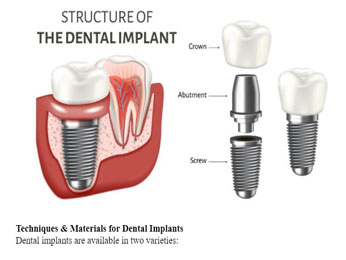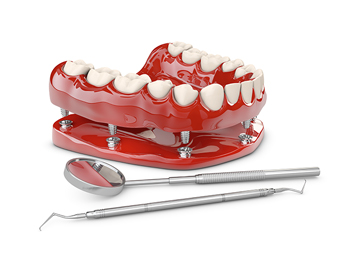Types of Dental Implants in India ?
How do dental implants work? An artificial tooth root called a dental implant is surgically inserted into your jawbone. It is a well-liked option for replacing missing or extracted teeth. For more than 30 years, dental implants have produced excellent dental restorations. Dental Implant Design and Function Three components comprise the dental implant's body, each of which has a specific purpose. 1. The screw or implant acts as the tooth's substitute root. 2. Between the implant screw and crown is a connecting post called an abutment. 3. The "artificial" tooth that sits on top of the abutment is called the crown. They appear and feel much like your natural teeth.

Techniques & Materials for Dental Implants
Dental implants are available in two varieties:
The Endosteal Implant
The type of implant most frequently utilized today is an endosteal implant (root-form implant). Alloplastic material, or artificial tissue graft, is used in its construction, along with titanium and tiny screws. The jawbone is surgically implanted with endosteal implants. The implants eventually fuse with the surrounding bone.
Undersurface Implant
Subperiosteal implants are very uncommon. However, they are a better choice for those whose native jawbones are insufficient to sustain endosteal implants. Under the gums is a subperiosteal implant (on or above the jawbone). It does not enter the jawbone surgically. 4 Types of Dental Implants There are different types of dental implants available:1. Single Tooth Implant
A single dental implant is ideal when one tooth is missing, and you want to replace it for aesthetics, comfort, and function. It requires one dental crown that connects to the implant screw.2. Implant-Supported Bridge
Implant-supported bridges are ideal for people with several missing teeth. The implant acts as an anchor for the bridge (instead of a natural tooth). A fixed dental bridge restores function by preventing other teeth from moving. It also improves eating and speaking functions.3. All-on-4 Dental Implants
All-on-4 implants are recommended when a patient is looking for a secure solution for many missing teeth. This solution restores your entire upper or lower jaw (or both arches). This is a permanent restoration. However, the overdenture can be removed for cleaning and dental exams.4. 3-on-6 Dental Implants
An alternative to an implant-retained denture is a 3-on-6 implant. It consists of three individual dental bridges attached to six dental implants.Benefits of Dental Implants
Dental implants have their benefits. However, they can also come with disadvantages. Here are the benefits of dental implants: Allows you to chew and speak normally Designed to look like your natural teeth, improving your self-esteem Reduces stress on your remaining natural teeth by offering independent support Preserves bone, reducing the appearance of aging Helps prevent loss of jaw height Easy to clean and care for With proper care, implants can last between 15 and 25 years Here are the disadvantages of getting dental implants: Will not whiten like your natural teeth Requires an invasive surgery for placement They are expensive (but the long-term benefits are usually worth it) Bone grafting may be necessary before placement if you do not have enough natural bone remaining Dental Implant Procedure: Step-By-Step Dental implant procedures are a type of outpatient surgery. Patients can return home on the same day of surgery. The procedure can take many months to complete due to the healing process and artificial tooth (crown) placement. Professionals who can perform dental implant surgery include: Oral and maxillofacial surgeons Periodontists Prosthodontists The procedure is separated into multiple steps, depending on the number of implants a patient needs:1. Remove the Tooth
If the damaged tooth is still in your mouth, the dentist will extract it. This step is not necessary if your tooth is already missing.2. Grafting and Jawbone Preparation
Patients who undergo implant surgery may have thin or soft jawbones. In this case, bone grafting will be necessary. It improves the quantity of bone and ensures the procedure doesn’t fail. The healing process for bone grafts takes a few months before a dental implant can be placed.3. Implant Placement
During the actual procedure, the oral surgeon exposes the bone by cutting the gums. An oral surgeon or periodontist drills holes into the bone. Then they position the implant (a post) deep into the bone, which functions as the tooth’s root. If a front tooth is being restored, the dentist will fill the space with a temporary removable solution while the implant heals below the gums. If it is a back tooth, they will not place anything over it.4. Healing and Growth
Osseointegration begins after the metal implant is placed in your jawbone. This is when the supporting bone begins to bond with the implant. This process can take several months to complete and ensures the base is sturdy enough to support an artificial tooth (dental crown).5. Abutment Placement (Crown Preparation)
After the healing process is complete, your dentist will place an abutment on top of the implant post. The abutment extends the implant above the soft tissue (gums). This step allows for easy placement of the dental crown.6. Crown Placement (Artificial Tooth)
Once the implant grows into the bone and is strong enough to support chewing, your dentist will make new impressions of your mouth. A dental technician will create a custom dental crown in a lab. The dental crown looks similar to your natural teeth and sits on the abutment (connector). It becomes the only visible part of the implant.7. Aftercare
Pain medications and antibiotics are usually prescribed post-op. It is important to only eat soft foods and practice excellent oral care habits during the healing process. Restrict the intake of alcohol, caffeine, and tobacco to see the best results. Regular check-ups are necessary during the first few months after the procedure. You should also keep up with regular dental exams post-surgery.Side Effects and Complications of Dental Implant Surgery
Most implant procedures are successful. However, there is still a risk of incorrect healing. To reduce this risk, practice good oral health care at home, including proper nutrition, brushing, and flossing. As with any dental surgery, minor discomfort is normal. Common side effects(that aren’t threatening to the implant) include: Gum and face swelling Bruises on the skin or gums Minor bleeding Pain where the implant was placed More serious complications that can develop after an implant is placed include: Damage to your surrounding teeth, gums, and/or blood vessels Infection at the implant site Prolonged bleeding Sinus issues and pressure (if the implant is placed in your upper jaw) Fractured jaw and jaw pain Nerve damage, which can lead to tingling in the mouth or lipsAbout Author: -
Dr. Vishwanath Hiremath. BDS, F.A.G.E, F.I.L.S, M.D.S, (PhD), 24+ Years Experience Dentist, Oral and Maxillofacial Surgeon, Facial – Cosmetic Surgeon, Aesthetic Dentist, and Implantologist.
About the Doctor: -
Dr. Vishwanath has successfully completed 24+ years of experience in the field of modern dentistry and practice. He graduated from “Manipal University,” Furter he has completed his post-graduation in “Oral and Maxillofacial Surgery” from Ambedkar Dental College & Research Institute. He is been dealing with major kinds of surgeries such as Facial Jaw Surgery, Cosmetics, and General Treatments. Recently he was awarded “Best Consultant Dentist and Maxillofacial Surgeon in South India” by the national health care awards,2019, and he is awarded “Best Consultant Dentist and Maxillofacial Surgeon in South India” by the Devoxil Media, 2021. His dedication, enthusiasm, and hard work all are reflected in his work. According to Dr. Vishwanath work is worship. He is the chairman of the “Dr. Hiremath Hospitals” and “Dr. Hiremath Dental Artistry.”

